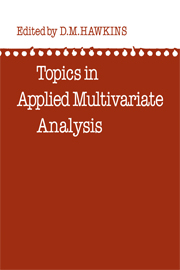Book contents
- Frontmatter
- PREFACE
- CONTRIBUTORS
- Contents
- CHAPTER 1 DISCRIMINANT ANALYSIS
- CHAPTER 2 COVARIANCE STRUCTURES
- CHAPTER 3 THE LOG-LINEAR MODEL AND ITS APPLICATION TO MULTIWAY CONTINGENCY TABLES
- CHAPTER 4 SCALING A DATA MATRIX IN A LOW-DIMENSIONAL EUCLIDEAN SPACE
- CHAPTER 5 AUTOMATIC INTERACTION DETECTION
- CHAPTER 6 CLUSTER ANALYSIS
- INDEX
CHAPTER 2 - COVARIANCE STRUCTURES
Published online by Cambridge University Press: 05 November 2011
- Frontmatter
- PREFACE
- CONTRIBUTORS
- Contents
- CHAPTER 1 DISCRIMINANT ANALYSIS
- CHAPTER 2 COVARIANCE STRUCTURES
- CHAPTER 3 THE LOG-LINEAR MODEL AND ITS APPLICATION TO MULTIWAY CONTINGENCY TABLES
- CHAPTER 4 SCALING A DATA MATRIX IN A LOW-DIMENSIONAL EUCLIDEAN SPACE
- CHAPTER 5 AUTOMATIC INTERACTION DETECTION
- CHAPTER 6 CLUSTER ANALYSIS
- INDEX
Summary
INTRODUCTION
Structural models for covariance matrices are used when studying relationships between variables and are employed predominantly in the social sciences. The best known of these is the factor analysis model but recently there has been rapid development of extensions and alternatives. Most of this work has appeared in psychometric journals. Textbooks on applied multivariate analysis are recently including chapters on factor analysis. They tend, however, to be out of date and give little attention to modern developments such as efficient computational methods in maximum likelihood factor analysis, effective methods for oblique rotation, methods for obtaining standard errors of factor loadings and extensions of the factor analysis model.
This paper will present a personal view of structural models for covariance matrices arising from continuous variates. The lack of robustness of statistical tests involving the assumption of multivariate normality will receive some attention and alternative approaches will be examined. Modern developments will be considered but no attempt will be made to provide an exhaustive review. Readers who require additional information are referred to the review article by Bentler (1980) and to the bibliographies in Harman (1976) and Mulaik (1972).
The paper is divided into two main parts. Part I is concerned with general technical background common to all structural models for covariance matrices. The manner in which covariance structures arise will be examined and general procedures for estimating parameters and comparing the adequacy of alternative models will be dealt with.
- Type
- Chapter
- Information
- Topics in Applied Multivariate Analysis , pp. 72 - 141Publisher: Cambridge University PressPrint publication year: 1982
- 343
- Cited by



